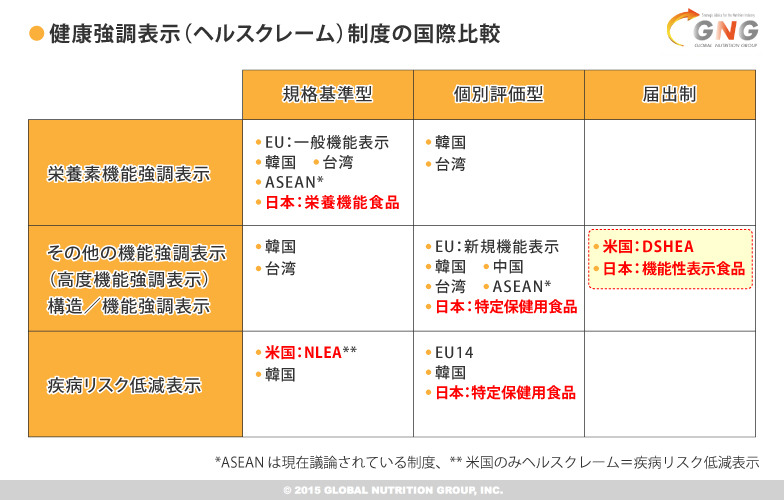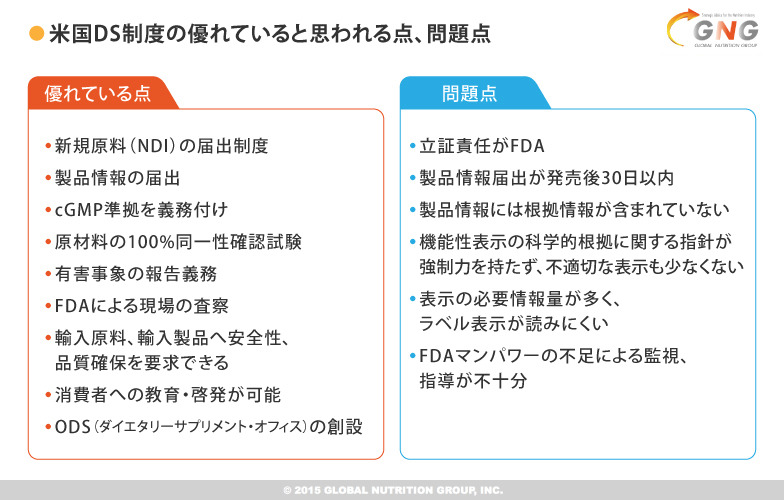Functional Claims Systems in the US and Japan: The Least Government Involvement
Takizawa: First, could you tell us where Japan's functional claims system stands compared to systems in other countries?
Takeda: For functional food claims, there's an international rule called the "Codex," jointly established by the WHO (World Health Organization) and FAO (Food and Agriculture Organization of the United Nations). Health claims (health-related claims) are divided into three tiers: ① Nutrient Function Claims, ② Other Function Claims (in the US called "Structure/Function Claims"), and ③ Disease Risk Reduction Claims.
From an institutional perspective, systems fall into three types: ① Standard-based systems where the government sets standards; ② Individual assessment systems where the government reviews and approves claims on a case-by-case basis; and ③ Notification systems where private companies submit notifications to the government. The figure below categorizes countries' systems according to these classifications.
[Figure 1]
As you can see, the U.S. system based on the Dietary Supplement Health and Education Act (DSHEA) and Japan's functional claims system both fall under "Other Functional Claims" for health claims and "Notification System" for their institutional aspects. These two countries' notification systems, characterized by extremely low government involvement, represent highly unique cases globally.
The United States, which declared that health maintenance directly impacts national finances
Takizawa: What are the key points of the U.S. system?
Takeda: The U.S. system is explicitly positioned as an education act established for the health benefits of consumers and to contribute to reducing national healthcare costs. It's not merely a labeling system; its underlying philosophy is to educate consumers.
Takizawa: What concerns prompted the establishment of this system in the U.S.?
Takeda: Examining the 15 explicit conditions attached when the bill passed Congress clearly reveals the U.S. government's concerns at the time and the system's objectives. The main points are as follows:
[Figure 2]
➊ Improving the health of the American people is a top priority for the United States federal government.
➋ The intake of certain nutrients and dietary supplements is associated with the prevention of adult diseases such as cancer, heart disease, and osteoporosis. Furthermore, some chronic diseases can be prevented through a diet centered on vegetables and plant-based foods.
➌ Self-medication, improved health literacy, adequate nutrition, and appropriate use of dietary supplements contribute to reducing the incidence of chronic diseases and lowering long-term care costs.
➍ A healthy lifestyle not only extends life expectancy but also reduces healthcare costs. Reducing healthcare costs is a critical issue for America's future and forms the foundation for economic development.
➎ Information from scientific research demonstrating the health benefits of dietary supplements should be disseminated, enabling consumers to choose preventive health management strategies based on this knowledge.
➏ While the federal government must take swift action against unsafe or substandard products, it must not simultaneously impose unreasonable restrictions that limit or delay consumers' access to safe products and accurate information.
Takeda: For about four years after implementation, we maintained a high growth rate of 13-14% year-on-year. However, it declined sharply in the late 1990s and early 2000s. This was due to factors like a surge in companies violating rules, such as making false claims on labels, and incidents of health damage occurring. It starkly illustrates that even if claims are backed by scientific evidence, consumer trust can be lost overnight due to misconduct by some companies. Another reason for the slowdown in growth was the publication of several negative academic papers on supplements at the time. This likely served as a counterpoint to the prominent exaggerated advertising, offering a scientific perspective. Nevertheless, despite these events, the supplement market size has consistently grown from the system's implementation until recent years. The average annual growth rate has been around 8%, maintaining a significantly higher growth rate than Japan's for over 20 years.
Japan's New System: Learning from the Successes and Failures of the U.S. System
Takizawa: What aspects do you consider to be strengths of the U.S. functional claims system?
[Figure 3]










